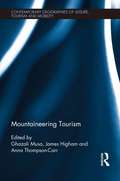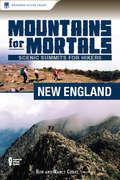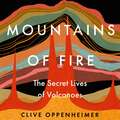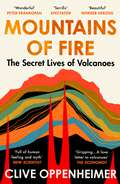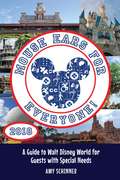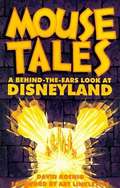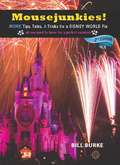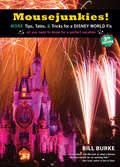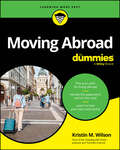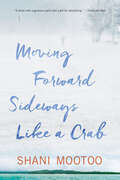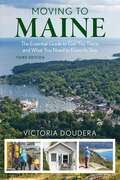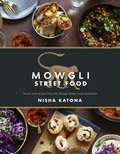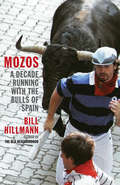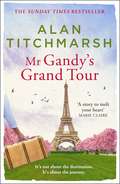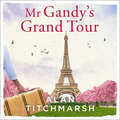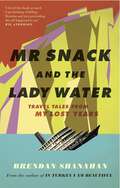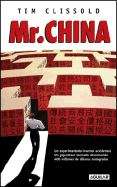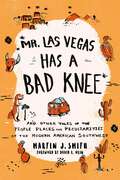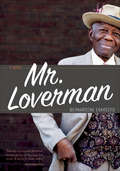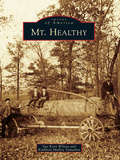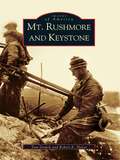- Table View
- List View
Mountain: Exploring Britain's High Places
by Griff Rhys JonesGriff Rhys Jones was a mountain virgin. So when it was suggested that he might like to go up a few of Britain’s peaks, he rightly asked: isn’t there someone better qualified? Apparently not. So Griff was duly dispatched across the rooftops of England, Scotland and Wales to explore some of the roughest, most arduous – not to mention most beautiful – terrain, and to meet those who live daily in such thin-aired wilds. Climbing the big mountains like Snowdon, Ben Nevis and Scafell Pike and many others besides gave Griff an insight into the passion and devotion our high places inspire – and turned a mountain virgin into a mountaineer. Well almost …
Mountaineering Tourism (Contemporary Geographies of Leisure, Tourism and Mobility)
by James Higham Anna Thompson-Carr Ghazali MusaIn May 1993 the British Mountaineering Council met to discuss the future of high altitude tourism. Of concern to attendees were reports of queues on Everest and reference was made to mountaineer Peter Boardman calling Everest an ‘amphitheater of the ego’. Issues raised included environmental and social responsibility and regulations to minimize impacts. In the years that have followed there has been a surge of interest in climbing Everest, with one day in 2012 seeing 234 climbers reach the summit. Participation in mountaineering tourism has surely escalated beyond the imagination of those who attended the meeting 20 years ago. This book provides a critical and comprehensive analysis of all pertinent aspects and issues related to the development and the management of the growth area of mountaineering tourism. By doing so it explores the meaning of adventure and special reference to mountain-based adventure, the delivering of adventure experience and adventure learning and education. It further introduces examples of settings (alpine environments) where a general management framework could be applied as a baseline approach in mountaineering tourism development. Along with this general management framework, the book draws evidence from case studies derived from various mountaineering tourism development contexts worldwide, to highlight the diversity and uniqueness of management approaches, policies and practices. Written by leading academics from a range of disciplinary backgrounds, this insightful book will provide students, researchers and academics with a better understanding of the unique aspects of tourism management and development of this growing form of adventure tourism across the world.
Mountains for Mortals: New England
by Ron Chase Nancy ChaseAlthough New England contains three of the four most densely populated states in the country, there are still numerous natural sites to be explored in this beautiful area, and this detailed guide catalogs the most unique and scenic mountains. From Mount Katahdin in Maine to the peaks above the coastline, the finest hikes are included here, along with beautiful photographs of the land and precise directions and descriptions.
Mountains of Fire: The Secret Lives of Volcanoes
by Clive OppenheimerA thrilling journey to the planet's most extreme places with volcanologist and filmmaker Professor Clive Oppenheimer, revealing how volcanoes have shaped us and our planet.Volcanoes mean more than threat and calamity. Like our parents, they've led whole lives before we get to know them. They have inspired our imaginations, provoked pioneering explorations and shaped the path of humanity.World-renowned volcanologist Clive Oppenheimer has worked at the crater's edge in the wildest places on Earth, from remote peaks in the Sahara to mystical mountains in North Korea. He's faced down AK47s, learned from tribal elders, and watched red hot rocks shoot into the sky. More people have been into space than have set eyes on the fiery depths of Mount Erebus in Antarctica, where he has measured the Earth's powerful forces. In Mountains of Fire, he paints volcanoes as otherworldly, magical places where our history is laid bare, and shows us just how entangled volcanic activity is with our climate, economy, politics, culture and beliefs.In a stunning blend of science, cultural history, myth and adventure, Mountains of Fire pulls out new lines of causation and correlation stretching around the globe, and reveals how deeply our stories are intertwined.(P) 2023 Hodder & Stoughton Limited
Mountains of Fire: The Secret Lives of Volcanoes
by Clive OppenheimerSHORTLISTED FOR THE BOARDMAN TASKER AWARD FOR MOUNTAIN LITERATURE'If Michael Palin had been a volcanologist, this is the book he would have written' LITERARY REVIEW'Gripping' THE ECONOMIST'Wonderful' PETER FRANKOPAN'Like a thriller ... This is terrific' SPECTATOR'Beautiful ... bursting with poetry, with storytelling' WERNER HERZOGWe are made of the same stuff as the breath and cinders of volcanoes. No matter where we live on the planet, they have shaped our history and might one day decide our destiny.World-famous volcanologist Clive Oppenheimer has worked at the crater's edge in the wildest places on Earth, close enough to feel the heat of the lava. In Mountains of Fire we join him on hair-singeing adventures from Italy to Antarctica to learn how deeply our stories are intertwined with volcanoes.
Mouse Ears For Everyone!: A Guide To Walt Disney World For Guests With Special Needs [2018 Edition]
by Amy Schinner Bob McLain"From dealing with the airlines and solving issues with wheelchairs and strollers, to managing expectations for character meet and greets, Amy brings to bear not only the hands-on experience with her own special needs child, but her organizational acumen as a regional chairperson for Autism Speaks. The book includes "sensory impact" evaluations for most rides, shows, and restaurants, and is sprinkled throughout with advice, tips, and lists to ensure a stress-free vacation"
Mouse Tales: A Behind-the-Ears Look at Disneyland
by Art Linkletter David KoenigThe first unauthorized behind-the-scenes look at the Happiest Place on Earth.
Mousejunkies!
by Bill BurkeA guidebook with a decidedly different approach, the second edition of Mousejunkies is a collection of humorous travelogues and insider how-to secrets compiled after scores of trips to Walt Disney World. The book draws on the insights of a panel of Disney fanatics - The Mousejunkies - following dozens of personal vacations, trade shows and press trips in recent years. This second edition brings everything up to date with countless new tips, tricks, and tales.Mousejunkies provides tips and travel plans told through personal accounts - something that sets it apart from all the other guides.All of the most important topics are covered: When to go, where to stay, what to do and where to eat. But readers will also learn how to indulge in an all-day chicken wing and beer football orgy at Walt Disney World, how to extract your family from Fantasmic with your sanity intact, where to catch a mid-afternoon catnap in the theme park, and even how wrong a Disney cruise can go.Mousejunkies is more than one travel writer's experiences at one of the most popular vacation destinations in the world. The Mousejunkies are a group of seemingly well-adjusted adults who have found themselves inexplicably drawn to Walt Disney World, again and again. Each has taken his or her own path, finding their way separately. When the smoke cleared, the group found itself back in reality, staring at one another over a pile of discarded annual passes and a useless collection of novelty hats.The stories - wry, humorous and told with an affection gained through years of Disney addiction - paint vivid portraits of a creatively engineered world, where unexpected surprises create lasting memories.The tips - valuable information designed to help readers get more out of their vacations - are told with a sly wink and the desire to share the secrets that make trips to central Florida more memorable.From touring plans to tongue-in-cheek reviews of the theme parks' restrooms, Mousejunkies provides readers with useful information couched in obsessively-detailed narrative with a humorous touch.
Mousejunkies!
by Bill BurkeA guidebook with a decidedly different approach, "Mousejunkies! 3rd Edition” is a collection of humorous travelogues and insider how-to secrets compiled after scores of trips to Walt Disney World. The book draws on the insights of a panel of Disney fanatics -- The Mousejunkies -- following dozens of personal vacations, trade shows and press trips in recent years. This third edition brings everything up to date with countless new tips, tricks, and tales. "Mousejunkies!” provides tips and travel plans told through personal accounts - something that sets it apart from all the other guides. All of the most important topics are covered: When to go, where to stay, what to do and where to eat. But readers will also learn Zen and the art of not melting down under the Florida sun, how to extract your family from Fantasmic with your sanity intact, where to catch a mid-afternoon catnap in the theme parks, and even how wrong things go when Epcrotch strikes. "Mousejunkies!” is more than one travel writer’s experiences at one of the most popular vacation destinations in the world. The Mousejunkies are a group of seemingly well-adjusted adults who have found themselves inexplicably drawn to Walt Disney World, again and again. Each has taken his or her own path, finding their way separately. When the smoke cleared, the group found itself back in reality, staring at one another over a pile of discarded annual passes and a useless collection of novelty hats. The stories - wry, humorous and told with an affection gained through years of Disney addiction - paint vivid portraits of a creatively engineered world, where unexpected surprises create lasting memories. The tips - valuable information designed to help readers get more out of their vacations - are told with a sly wink and the desire to share the secrets that make trips to central Florida more memorable. From touring plans to tongue-in-cheek reviews of the theme parks’ restrooms, "Mousejunkies!” provides readers with useful information couched in obsessively-detailed narrative with a humorous touch.
Moving Abroad For Dummies
by Kristin M. WilsonExpert guidance for anyone who wants to settle down in another country Moving Abroad For Dummies is for anyone contemplating pulling the trigger on moving out of their homeland for a short time or for good. Be it to enhance a career, retire more comfortably on savings, or find a culture that's a better fit for you, relocating abroad takes some planning to be done right. This book walks you through all the considerations and the steps you'll need to take to make it happen. Author Kristin Wilson is a relocation expert with over 20 years of experience both living abroad and helping hundreds of others do the same. In this confusion-clearing guide, she offers must-know information on planning a move, getting affairs in order before hitting the road, and settling into your new home. Find out whether becoming an expat is the right move for you Learn how to budget for your new life, find a home abroad, and handle culture shock Become a permanent resident of your new country of choice Decide whether and when to return home At every stage of the moving abroad process—decision making, preparation, and adjustment to a new culture—this clear and easy-to-read Dummies guide has your back.
Moving Forward Sideways Like a Crab
by Shani MootooLong-listed for Canada's Scotiabank Giller Prize.Short-listed for the Lambda Literary Award."Readers who enjoy rich details of place will find Mootoo's writing about her settings to be luxuriant; we are especially treated to abundant descriptions of Trinidad...[A] thoughtful exploration of place and identity."--Kirkus Reviews"Mootoo's character-driven novel is rich in setting and slow in pace, inviting the reader to linger over its closely observed details. "--Booklist"Mootoo has produced a stunning meditation on story...[This novel] portrays the beautiful (yet often tense) bond between a parent and child, the complexities of immigration, the fluidity of gender, and provides a juxtaposition between two extreme climates, Toronto and Trinidad. It is a gorgeously written novel."--National Post (Canada)"Jonathan Lewis-Adey's mother left when he was nine, but when he finds his estranged parent again, he is surprised to find that the person he knew as his mother has become a man named Sydney. Set in the Trinidad of her upbringing, Shani Mootoo's vivid writing explores the pain and confusion Jonathan experiences as a result of Sydney's choices."--World Literature Today, included in the Nota Bene section"A fascinating premise that gives voice to the queer-identified...Mootoo's brilliant evocations of [Trinidad's] paradisiacal glow...are a real gift to the reader."--Globe and Mail (Canada)"In rich and vivid descriptive prose, Mootoo portrays her characters' journeys between countries and toward greater selfhood."--Quill & Quire, starred review"The novel's greatest triumph is its painfully poignant characterization of a privileged son, who cannot always embrace the transition that his mother--now father--has made."--Asian American Literature Fans"Queer Canadian visual artist and writer Shani Mootoo's latest novel Moving Forward Sideways Like a Crab follows the journey of writer Jonathan as he searches for the mother who left when his parents divorced."--Baltimore Out Loud"A powerfully moving tribute to the lasting power of storytelling and the surprising and unpredictable nature of human emotion. It's truly an excellent literary feat and a great story to get lost in!"--Bookworm Shawn (blog)Jonathan Lewis-Adey was nine when his parents separated, and his mother, Sid, vanished entirely from his life. It is not until he is a grown man that Jonathan finally reconnects with his beloved lost parent, only to find, to his shock and dismay, that the woman he knew as "Sid" in Toronto has become an elegant man named Sydney living in his native Trinidad. For nine years, Jonathan has paid regular visits to Sydney on his island retreat, trying with quiet desperation to rediscover the parent he adored inside this familiar stranger, and to overcome his lingering confusion and anger at the choices Sydney has made.At the novel's opening, Jonathan is summoned urgently to Trinidad where Sydney, now aged and dying, seems at last to offer him the gift he longs for: a winding story that moves forward sideways as it reveals the truths of Sydney's life. But when and where the story will end is up to Jonathan, and it is he who must decide what to do with Sydney's haunting legacy of love, loss, and acceptance.
Moving to Maine: The Essential Guide to Get You There and What You Need to Know to Stay
by Victoria DouderaThis is a completely revised and expanded edition of the best-selling, comprehensive guide covering not only reasons to move to Maine but also what newcomers will find once they get here. The book answers questions about what Maine is really like as a place to live, providing a broad range of information about schools, housing, cultural life, taxes, work and employment opportunities, and even the weather.
Mowgli Street Food: Authentic Indian Street Food
by Nisha KatonaThis is real Indian food; the bright, fresh, light, herb- and spice-lifted food that Indians turn to each and every day. Extremely healthy, beautifully simple and packed with fresh flavour, it’s not your parents’ Indian food.In 2014, barrister Nisha Katona had a nagging obsession to build a restaurant serving the kind of food Indians eat at home and on the street. The first Mowgli restaurant opened in Liverpool in late 2014, blowing away the critics and forming legions of fans.The simple dishes of a Mowgli menu are a million miles away from the curry stereotype. This unique collection of recipes and stories from the Mowgli Street Food restaurants brings you the best of their beloved menu, and much more. Try delicious snacks such as Fenugreek Kissed Fries or a Masala Wrap, and spice up your dinner with a whole host of delicious dahls. Discover how to recreate the iconic Angry Bird, the signature flavours of the House Lamb Curry, and of course, the secrets of the taste explosion that are Chat Bombs. And indulge in desserts, drinks and cocktails such as the Cardamom Custard Tart or a Sweet Delhi Diazepam.From the Mowgli Chip Butty to the iconic Yogurt Chat Bombs, Mother Butter Chicken to Calcutta Tangled Greens, this is the definitive collection of Mowgli’s signature street food dishes to recreate at home.
Mozos: A Decade Running with the Bulls of Spain
by Bill HillmannWith a journalist's ear for detail, master-storyteller "Buffalo" Bill Hillmann narrates his decade-long journey of self-discovery, exploring his transformation from wasted ex-Golden Gloves champ lost in street brawls and cocaine deals on the Chicago streets to running with a world-renowned crew of mozos, masters in the art of running with the bulls. Includes a first-hand account of his infamous goring.
Mr Gandy's Grand Tour: The uplifting, enchanting novel by bestselling author and national treasure Alan Titchmarsh
by Alan TitchmarshTimothy Gandy has kept his lifetime's ambition secret for forty years.Now, suddenly (if tragically) released from the hen-pecked tedium of his ordinary existence, he is unexpectedly free to realize his dreams.He will embark on a Grand Tour of Europe, following in the footsteps of the aristocrats of the eighteenth century.He anticipates high art, culture and pleasant weather. He never expected to encounter new friendships - and possibly even love - along the way. It seems that Mr Gandy has embarked on the journey of a lifetime . . .READERS ARE LOVING MR GANDY'S GRAND TOUR:'Another heartwarming story from Alan Titchmarsh' - 5 STARS'Well worth reading' - 5 STARS'What a sweet tale this was' - 5 STARS'Loved it!' - 5 STARS'Enchanting' - 5 STARS
Mr Gandy's Grand Tour: The uplifting, enchanting novel by bestselling author and national treasure Alan Titchmarsh
by Alan TitchmarshTimothy Gandy has kept his lifetime's ambition secret for forty years.Now, suddenly (if tragically) released from the hen-pecked tedium of his ordinary existence, he is unexpectedly free to realize his dreams.He will embark on a Grand Tour of Europe, following in the footsteps of the aristocrats of the eighteenth century.He anticipates high art, culture and pleasant weather. He never expected to encounter new friendships - and possibly even love - along the way. It seems that Mr Gandy has embarked on the journey of a lifetime...(P)2016 Hodder & Stoughton
Mr Murder: A brilliant thriller of heart-stopping suspense
by Dean KoontzIs he all that he seems...? Dean Koontz writes a chilling thriller in Mr Murder, a tale of one family... and a deadly killer. Perfect for fans of Richard Laymon and Stephen King.'The resounding variations Mr. Koontz plays on this good story, here craftily retold... allow him to counterpoint the new horrors about us with the old horrors already inside us' - The New York Times Book Review For author Martin Stillwater, life couldn't be more perfect. He and Paige are happy together; their two daughters, Emily and Charlotte, are intelligent and healthy; and his novels are achieving long-hoped-for levels of success. So why does he feel such dread and experience sudden blackouts?The killer doesn't know his own name, only the name he uses. He has no family, no friends, no home. He cannot recall who gives him his assignments, and he doesn't know why his targets must die. Now, however, he senses that in a town he can't yet envision, a life awaits him, a place to call home, with family and friends.Charlotte knows something is wrong: the man moves and sounds like Daddy, but he doesn't smile as quickly or as often as usual. And when he does smile, he seems to be pretending. Daddy isn't Daddy. What readers are saying about Mr Murder: 'Many spectacular, nail biting sequences''Exciting from start to finish. This masterful writer took me on a roller-coaster ride of emotions''One of Dean Koontz' best books... suspenseful and difficult to put down'
Mr Snack and the Lady Water: Travel Tales From My Lost Years
by Brendan ShanahanAfter a decade spent on the road, renowned travel writer Brendan Shanahan is back with Mr Snack and the Lady Water, a collection of darkly funny and unexpected travel writing. In the title piece, Shanahan embarks on what is supposed to be a luxury cruise, only to find himself on a three-day endurance test aboard a leaking barge on China's Yangtze River in the company of a mysterious roommate, a pair of neurotic American spinsters and a thousand baseball-capped tourists. Other stories include his sight-unseen, online purchase of a house in Las Vegas, his brief career in Bollywood and a meditation on white guilt in post-apartheid South Africa. Road-soiled and a touch deviant, Shanahan's account of his 'lost years' are a comic master class, essential reading for anyone who has ever woken up in a strange bed or just stared at themselves in a hotel mirror at 3 am and asked 'Where am I?'
Mr. China
by Tim ClissoldLa increíble historia de un banquero de Wall Street que viaja a China con cuatrocientos millones de dólares y aprende, de la manera más dura, que ese país no juega con las mismas reglas de Occidente. A principios de los noventa, cuando China abrió finalmente sus puertas a los negocios, Wall Street de inmediato quiso entrar. La llegada de los banqueros de Nueva York, con sus especializaciones en Harvard, sus camisas de rayas y sus mocasines con borlas, listos para negociar con los viejos amos chinos, crea el escenario perfecto para un choque entre los billones de Wall Street y la cultura más antigua del mundo. Tomada de la vida real, ésta es la historia de un recio banquero que se traslada a China buscando la gloria. Decidido a montarse en la gran ola de la inversión, se une con un ex guardia rojo y un inglés que habla mandarín. Entre los tres consiguen cuatrocientos millones de dólares y compran fábricas por todo el país. Pero cuando creen que con los contratos que han firmado tienen todo bajo control, comienzan a darse cuenta de que en China las cosas no funcionan de la manera que ellos conocen y son testigos de cómo desaparecen sus millones. "Ésta es una historia increíble... bien escrita, que absorbe completamente la atención y es muy divertida." Literary Review "Todas las compañías que tienen sede en China deberían armar a sus ejecutivos con una copia de esta sorprendente, divertida y culturalmente comprensiva historia de los peligros de hacer negocios en el salvaje oeste asiático". "Los libros del año" de The Economist
Mr. Las Vegas Has a Bad Knee: and Other Tales of the People, Places, and Peculiarities of the Modern American Southwest
by Martin J. SmithFor more than thirty years, journalist and author Martin J. Smith has traveled the American West, chasing offbeat stories that often are bizarre, always compelling, and at times profound. His journey through that oft-idealized and misunderstood landscape has made him a witness to some of the West&’s most interesting places, people, and events, from his Valentine&’s Day at Nevada&’s Mustang Ranch brothel to the deathbed of a man who spent three decades building two 150-ton concrete dinosaurs in the desert; from the eviction of a fading rock star from his mansion to the guitar king&’s improbable resurrection more than a decade later; from the final rampage of an unlikely Colorado martyr to his marathon stint watching the driver&’s ed snuff films of the California Highway Patrol. He spent a lot of time in the only pet cemetery in idyllic Orange County, Calif.This collection of essays, often told with the wisdom and perspective of a writer looking back, chronicles in vivid detail the heroes, heels, and cultural spasms of an endlessly fascinating frontier. Smith hits the road with marginalized astronaut Buzz Aldrin, the second man on the moon, and dives into the middle of a corporate and existential crisis at Sea World, where friendly mascot Shamu had just drowned its trainer. He tests open water swimming with a Southern California woman who eventually swam to Antarctica. He exposes the huckster behind the worldwide Whaling Wall fraud, tours L.A. with a tireless band of Japanese honeymooners, visits the factory where the world&’s finest fake rocks are made, and retrieves balls for the seventysomething podiatrist who holds the world record for basketball freethrow shooting.
Mr. Loverman: A Novel
by Bernardine EvaristoBarrington Jedidiah Walker is seventy-four and leads a double life. Born and bred in Antigua, he's lived in Hackney, London, for years. A flamboyant character with a fondness for William Shakespeare, Barrington is a husband, father, grandfather—and also secretly gay. With an abundance of laugh-out-loud humor and wit, Mr. Loverman explodes cultural myths and shows the extent of what can happen when people fear the consequences of being true to themselves.<P> His deeply religious and disappointed wife, Carmel, thinks he sleeps with other women. When their marriage goes into meltdown, Barrington wants to divorce Carmel and live with Morris, but after a lifetime of fear and deception, will he manage to break away? With an abundance of laugh-out-loud humor and wit, Mr. Loverman explodes cultural myths and shows the extent of what can happen when people fear the consequences of being true to themselves.
Mr. Men: Road Trip! (Mr. Men and Little Miss)
by Adam HargreavesHit the road with the Mr. Men Little Miss crew and get ready to laugh your way across the USA!The Mr. Men Little Miss crew is traveling across America on a road trip that has something for everyone, from Niagara Falls to the Grand Canyon to the Hollywood Walk of Fame. With visits to the biggest and most famous sights--like the Statue of Liberty, the Gateway Arch, and the Golden Gate Bridge--this team is sure to have an adventure anywhere they go!
Mrs. Shipley's Ghost: The Right to Travel and Terrorist Watchlists
by Jeffrey KahnToday, when a single person can turn an airplane into a guided missile, no one objects to rigorous security before flying. But can the state simply declare some people too dangerous to travel, ever and anywhere? Does the Constitution protect a fundamental right to travel? Should the mode of travel (car, plane, or boat) or itinerary (domestic or international) make a constitutional difference? This book explores the legal and policy questions raised by government travel restrictions, from passports and rubber stamps to computerized terrorist watchlists. In tracing the history and scope of U. S. travel regulations, Jeffrey Kahn begins with the fascinating story of Mrs. Ruth Shipley, a federal employee who almost single-handedly controlled access to passports during the Cold War. Kahn questions how far national security policies should go and whether the government should be able to declare some individuals simply too dangerous to travel. An expert on constitutional law, Kahn argues that U. S. citizens’ freedom to leave the country and return is a fundamental right, protected by the Constitution.
Mt. Healthy (Images of America)
by Kathleen Mulloy Tamarkin Sue Korn WilsonLocated in southwestern Ohio, Mt. Healthy evolved from a pioneer village on the Hamilton Turnpike into a bustling community center in the early 1900s that attracted students and shoppers from surrounding areas. Early settlers were diverse in beliefs and abilities. They were patriotic and hardworking and valued education. Together they built a supportive village in which to live. Their children grew to be productive citizens who were thrifty and industrious in their lives, and that tradition continues today. Mt. Healthy is known for its healthy environment, its unique tailoring industry from 1850 to the 1940s, and its business district that consists of historic commercial buildings constructed with various architectural styles.
Mt. Rushmore and Keystone
by Tom Domek Robert E. HayesIn the heart of a geological upthrust, four presidents, memorialized in granite, gaze across the rugged country of South Dakota's Black Hills. At the foot of the mountain lies Keystone, a small community indelibly linked to the carving of Mount Rushmore. In 1876, prospectors swarmed into the central Black Hills in search of gold. While they did find it, these early miners also found other minerals, such as tin and feldspar. By the turn of the 20th century, Keystone was well-known for its mineral riches, but also for the boom and bust cycles that often accompany mining. The town's future was guaranteed in 1925, however, when Gutzon Borglum, a noted sculptor, arrived to secure a location for a monument to American democracy. Borglum drew heavily on the skills of Keystone miners, putting them to work on a mountain that would soon portray the images of Presidents Washington, Jefferson, Lincoln, and Roosevelt. In this book, readers will find vintage photographs--many never before published--that, along with engaging narrative, tell the story of Keystone and the carving of Mount Rushmore.

